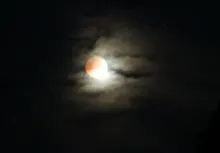
A partial lunar eclipse is an astronomical event where the Earth comes between the Sun and the Moon, but only part of the Moon enters Earth's shadow. During this event, a portion of the Moon will darken as it passes through the Earth’s umbra (the central, darkest part of the shadow), creating a beautiful contrast between the shadowed and non-shadowed areas of the Moon. The October 2024 Partial Lunar Eclipse promises to be a captivating experience for skywatchers worldwide, as it will be visible from many parts of the world, including Europe, Africa, Asia, and Australia.
What is a Partial Lunar Eclipse?
Lunar eclipses occur during a full moon when the Moon moves into the Earth's shadow. Unlike a total lunar eclipse, where the Moon is entirely engulfed in Earth's umbra, a partial lunar eclipse happens when only a part of the Moon passes through the shadow. This results in a portion of the Moon appearing much darker than the rest. The October 2024 eclipse will have a significant part of the Moon covered by the Earth's umbra, making it visually stunning.
Timing and Visibility of the October 2024 Partial Lunar Eclipse
The partial lunar eclipse on October 18, 2024, will be visible in various parts of the world. The visibility and timing of this eclipse will depend on your geographical location. Here’s a breakdown of key times (UTC):
- Penumbral Eclipse Begins: 16:01 UTC
- Partial Eclipse Begins: 17:35 UTC
- Maximum Eclipse: 18:14 UTC
- Partial Eclipse Ends: 18:53 UTC
- Penumbral Eclipse Ends: 20:26 UTC
The maximum eclipse, when the Moon is at its darkest, will occur at 18:14 UTC, making this the peak time for viewing. For regions where the Moon will be high in the sky, such as parts of Europe, Africa, and western Asia, the eclipse will be an impressive sight.
How to View the Eclipse Safely
One of the great advantages of lunar eclipses is that they can be viewed safely with the naked eye, unlike solar eclipses. The October 2024 partial lunar eclipse can be enjoyed with binoculars or a small telescope, but no special equipment is required to appreciate its beauty.
For an enhanced experience, consider using a camera with a zoom lens to capture the contrast between the illuminated and shadowed parts of the Moon. As with all lunar events, finding a dark, clear location away from city lights will improve visibility and make the experience more memorable.
Historical and Cultural Significance of Lunar Eclipses
Lunar eclipses have held a special place in cultures around the world for centuries. In many ancient civilizations, they were seen as omens or signs from the gods. The changing appearance of the Moon often inspired myths, legends, and stories. For instance, in Chinese folklore, a lunar eclipse was thought to occur when a celestial dragon devoured the Moon. In Hindu mythology, the demon Rahu is believed to chase the Moon and Sun, occasionally catching them to cause eclipses.
In modern times, while the superstitions have faded, the wonder of watching an eclipse remains a timeless experience, reminding us of our place in the universe.
Tips for Observing the Partial Lunar Eclipse
- Check the Timing for Your Location: Use online tools or an astronomy app to determine the exact time the eclipse will be visible in your region.
- Find an Optimal Viewing Spot: Look for a location with an unobstructed view of the sky. Hills, rooftops, and open fields are ideal.
- Watch the Moon’s Movement: The eclipse will progress over a couple of hours, allowing observers to see the gradual darkening and brightening of the Moon.
- Photography Tips: If you want to photograph the eclipse, use a tripod for stability, a zoom lens to capture details, and experiment with exposure settings to capture the varying light conditions.
When is the Next Partial Lunar Eclipse?
For eclipse enthusiasts, the good news is that there are always more eclipses to look forward to. The next partial lunar eclipse will occur on March 25, 2024, making October’s event a preview for the celestial shows to come in the coming years.
The partial lunar eclipse of October 2024 is a reminder of the celestial choreography that takes place in our skies, providing an opportunity to look up and connect with the wonders of the universe. Whether you are an avid astronomer or a casual skywatcher, this event is worth marking on your calendar. Set aside some time, gather with family and friends, and enjoy the spectacle of the Moon gracefully dancing through Earth's shadow.
